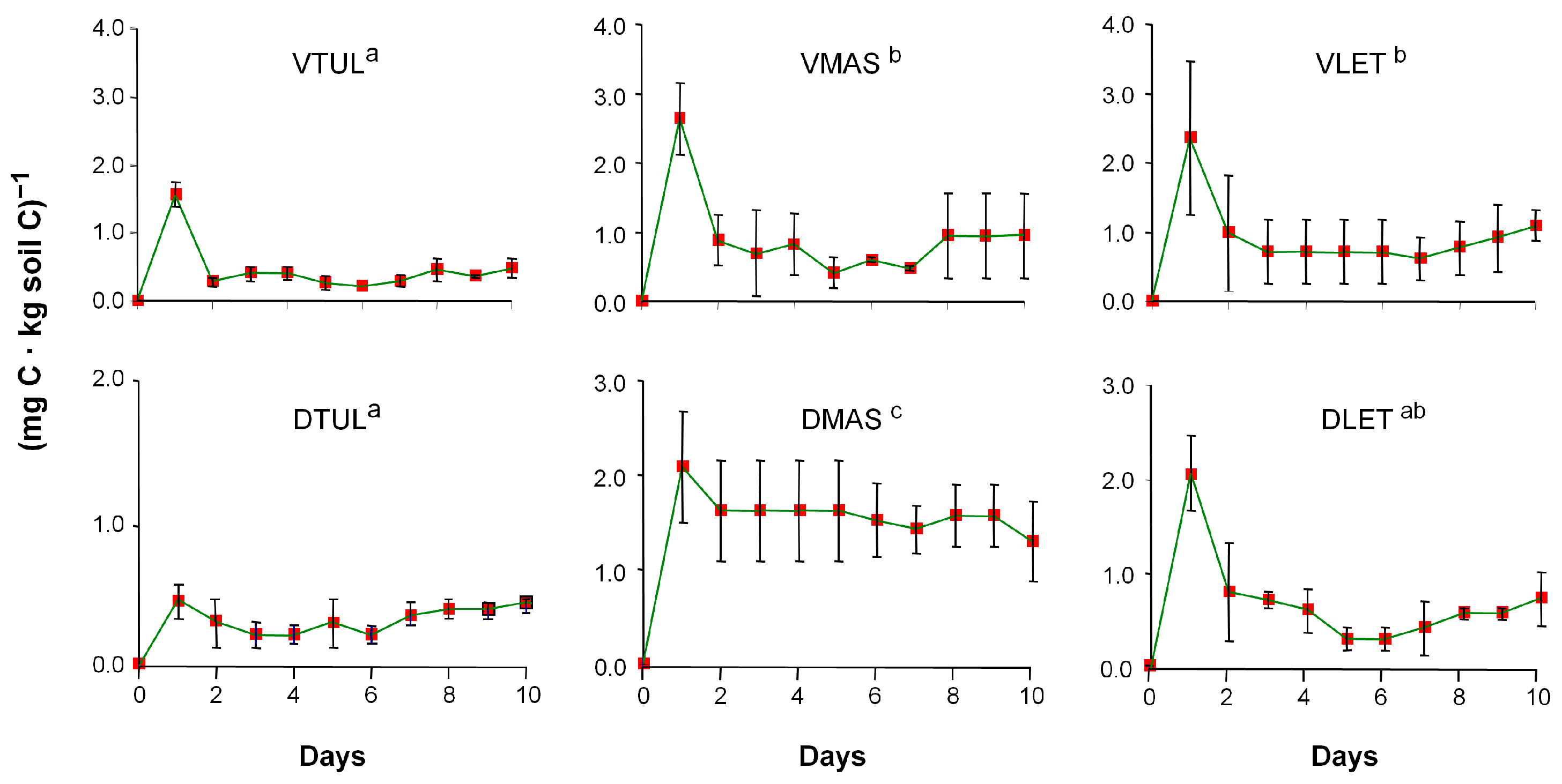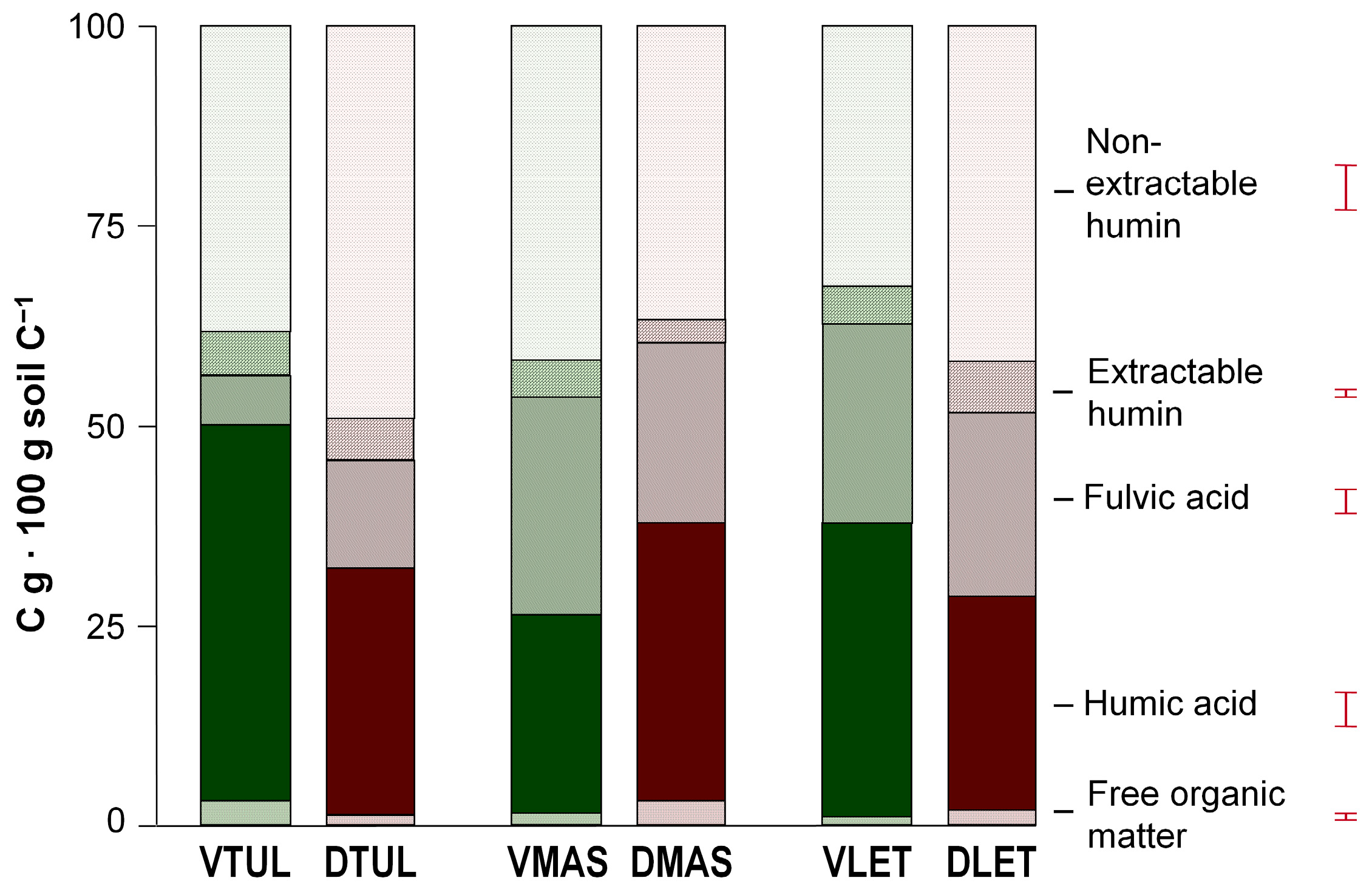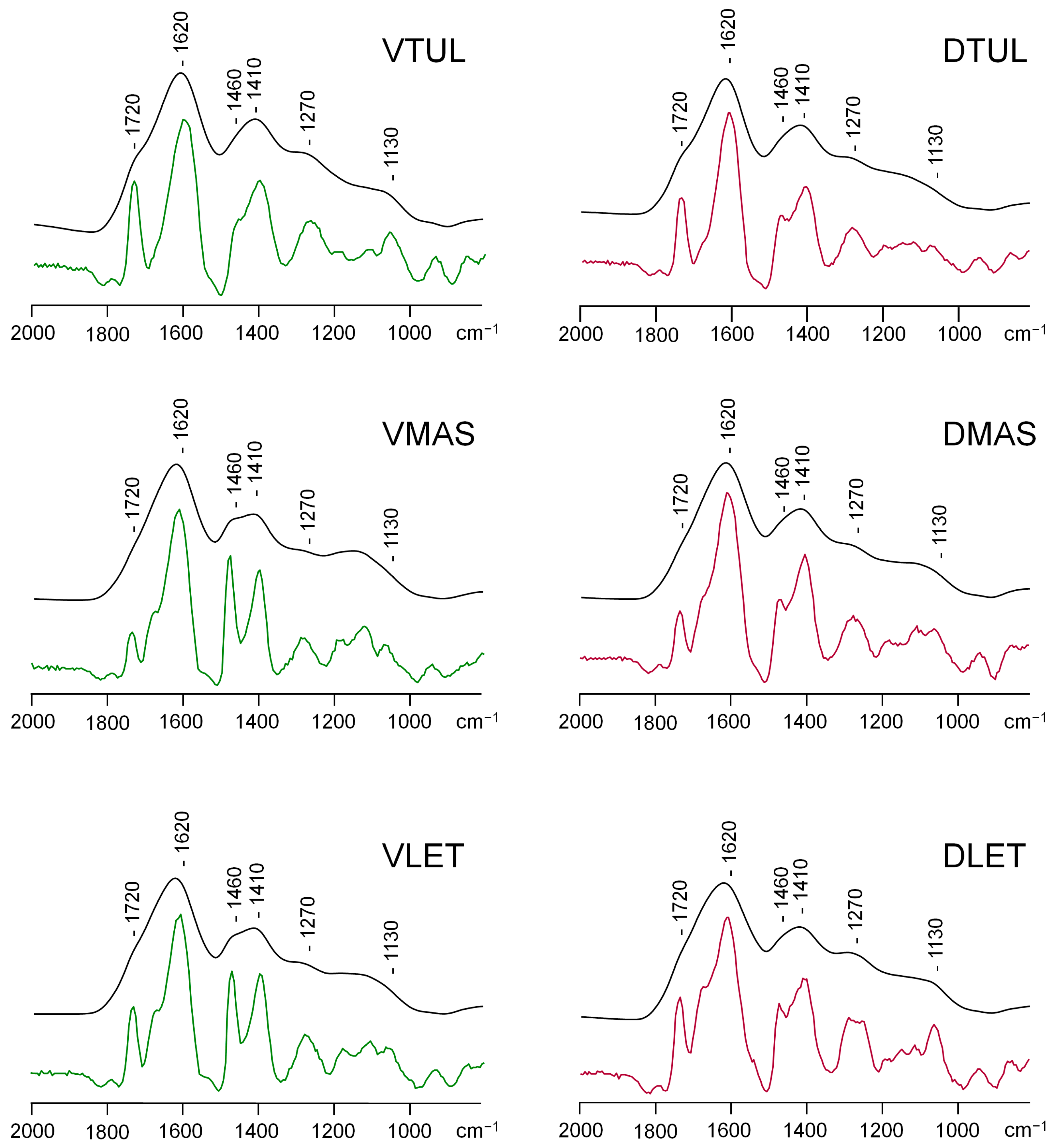Changes in Soil Organic Matter Associated with Land Use of Arenosols from Southern Botswana
Abstract
:1. Introduction
2. Materials and Methods
2.1. Sampling
2.2. General Analyses
2.3. Soil Respiratory Activity
2.4. Soil Humus Fractions
2.5. Humic Acid Characteristics
2.6. Statistical Data Treatments
3. Results
3.1. General Characteristics
3.2. Soil Respiratory Activity
3.3. Soil Organic Matter Fractions
3.4. Humic Acid Characteristics
4. Discussion
4.1. General Characteristics
4.2. Soil Respiratory Activity
4.3. Soil Organic Matter Fractions
4.4. Humic Acid Characteristics
4.5. Multivariate Data Treatments
Author Contributions
Funding
Data Availability Statement
Acknowledgments
Conflicts of Interest
References
- Kgathi, D.L.; Sekhwela, M.B.M.; Tietema, T.; Mpotokwane, M.A. Biomass in Botswana. In Biomass Energy and Coal in Africa; Hall, D.O., Mao, Y.S., Eds.; Zed Books Ltd.: London, UK, 1994. [Google Scholar]
- Romanens, R.; Pellacani, F.; Mainga, A.; Fynn, R.; Vittoz, P.; Verrecchia, E.P. Soil diversity and major soil processes in the Kalahari basin, Botswana. Geoderma Reg. 2019, 19, e00236. [Google Scholar] [CrossRef]
- Sekhwela, M.B.M. Woody Biomass and Deforestation in Southern African Region: Implications for Global Change Research. In Towards Sustainable Management in the Kalahari Region—Some Essential Background and Critical Issues; Ringrose, S., Raban, C., Eds.; Directorate of Research and Development, University of Botswana: Gaborone, Botswana, 2000; pp. 100–119. [Google Scholar]
- Sekhwela, M.B.M.; Yates, D.; Lamb, D. Woody Vegetation Structure and Wood Availability in Arid and Semi-Arid Kalahari Sand System of Botswana. In Towards Sustainable Management in the Kalahari Region—Some Essential Background and Critical Issues; Ringrose, S., Raban, C., Eds.; Directorate of Research and Development, University of Botswana: Gaborone, Botswana, 2000; pp. 65–84. [Google Scholar]
- Weinzierl, T.; Wehberg, J.; Böhner, J.; Conrad, O. Spatial assessment of land degradation risk for the Okavango river catchment, southern Africa. Land Degrad. Dev. 2016, 27, 281–294. [Google Scholar] [CrossRef]
- Mulale, K.; Chanda, R.; Perkins, J.S.; Magole, L.; Sebego, R.J.; Atlhopheng, J.R.; Mphinyane, W.; Reed, M.S. Formal institutions and their role in promoting sustainable land management in Boteti, Botswana. Land Degrad. Dev. 2014, 25, 80–91. [Google Scholar] [CrossRef]
- Perkins, J.; Reed, M.; Akanyang, L.; Atlhopheng, J.; Chanda, R.; Magole, L.; Mphinyane, W.; Mulale, K.; Sebego, R.; Fleskens, L.; et al. Making land management more sustainable: Experience implementing a new methodological framework in Botswana. Land Degrad. Dev. 2013, 24, 463–477. [Google Scholar] [CrossRef]
- Stringer, L.C.; Reed, M.S. Land degradation assessment in southern Africa: Integrating local and scientific knowledge bases. Land Degrad. Dev. 2007, 18, 99–116. [Google Scholar] [CrossRef]
- Neba, S.C.; Tsheko, R.; Kayombo, B.; Moroke, S.T. Variation of soil organic carbon across different land covers and land uses in the greater Gaborone region of Botswana. World J. Biol. Pharm. Health Sci. 2022, 7, 97–112. [Google Scholar] [CrossRef]
- Alemaw, B.F.; Chaoka, T.R.; Totolo, O. Investigation of sustainability of rain-fed agriculture through soil moisture modeling in the Pandamatenga Plains of Botswana. Phys. Chem. Earth Parts A/B/C 2006, 31, 960–966. [Google Scholar] [CrossRef]
- Neba, S.C.; Tsecko, R. Spatial and temporal variation of soil properties and soil organic carbon in semi-arid areas of Sub-Sahara Africa. Geoderma Reg. 2024, 36, e00770. [Google Scholar]
- Almendros, G.; Kgathi, D.; Sekhwela, M.; Zancada, M.C.; Tinoco, P.; Pardo, M.T. Biogeochemical assessment of resilient humus formations from virgin and cultivated northern Botswana soils. J. Agric. Food Chem. 2003, 51, 4321–4330. [Google Scholar] [CrossRef]
- Wang, L.; D’Odorico, P.; Ringrose, S.; Coetzee, S.; Macko, S.A. Biogeochemistry of Kalahari sands. J. Arid Environ. 2007, 71, 259–279. [Google Scholar] [CrossRef]
- Lyndsay, W.L.; Norvell, W.A. Development of a DTPA soil test for zinc, iron, manganese and copper. Soil Sci. Soc. Am. J. 1978, 42, 421–428. [Google Scholar] [CrossRef]
- Nelson, D.V.; Sommers, L.E. Total carbon, organic carbon and organic matter. In Methods of Soil Analysis: Part 2, Chemical and Microbiological Properties, 2nd ed.; Page, A.L., Miller, R.H., Keeney, D.R., Eds.; American Society of Agronomy: Madison, WI, USA, 1982; pp. 539–579. [Google Scholar]
- Chone, T.; Jacquin, F.; Yaghi, M. Emploi de 14C et 45Ca comme éléments traceurs de l’humification. Bull. ENSAIA 1973, 15, 69–83. [Google Scholar]
- Almendros, G.; González Vila, F.J.; Martin, F. Fire induced transformation of soil organic matter from an oak forest. An experimental approach to the effects of fire on humic substances. Soil Sci. 1990, 149, 158–168. [Google Scholar] [CrossRef]
- Duchaufour, P.; Jacquin, F. Comparaison des processus d’humification dans les principaux types d’humus forestiers. Bull. AFES 1975, 1975, 29–36. [Google Scholar]
- Dabin, B. Étude d’une méthode d’extraction de la matière humique du sol. Sci. Sol. 1971, 2, 15–24. [Google Scholar]
- Traina, S.; Novak, J.; Smeck, N.E. An ultraviolet absorbance method of estimating the percent aromatic carbon content of humic acids. J. Environ. Qual. 1990, 19, 151–153. [Google Scholar] [CrossRef]
- Rosenfeld, A.; Kak, A.C. Digital Picture Processing; Academic Press: New York, NY, USA, 1982; Volume I. [Google Scholar]
- Almendros, G.; Sanz, J. A structural study of alkyl polymers in soil after perborate degradation of humin. Geoderma 1992, 53, 79–95. [Google Scholar] [CrossRef]
- Fisher, R.A. The Design of Experiments; Oliver and Boyd Ltd.: Edinburgh, UK, 1949. [Google Scholar]
- Kruskal, J.B. Multidimensional scaling by optimizing goodness of fit to a nonmetric hypothesis. Psychometrika 1964, 29, 1–27. [Google Scholar] [CrossRef]
- Chen, Y.; Senesi, N.; Schnitzer, M. Information provided on humic substances by E4/E6 ratios. Soil Sci. Soc. Am. J. 1977, 41, 352–358. [Google Scholar] [CrossRef]
- Ringrose, S.; Matheson, W.; Wolski, P.; Huntsman-Mapila, P. Vegetation cover trends along the Botswana Kalahari transect. J. Arid Environ. 2003, 54, 297–317. [Google Scholar] [CrossRef]
- Wang, L.; Okin, G.S.; Caylor, K.K.; Macko, S.A. Spatial heterogeneity and sources of soil carbon in southern African savannas. Geoderma 2009, 149, 402–408. [Google Scholar] [CrossRef]
- Feral, C.J.W.; Epstein, H.E.; Otter, L.; Aranibar, J.N.; Shugart, H.H.; Macko, S.A.; Ramontsho, J. Carbon and nitrogen in the soil–plant system along rainfall and land-use gradients in southern Africa. J. Arid Environ. 2003, 54, 327–343. [Google Scholar] [CrossRef]
- O’Halloran, L.R.; Shugart, H.H.; Wang, L.; Caylor, K.K.; Ringrose, S.; Kgope, B. Nutrient limitations on aboveground grass production in four savanna types along the Kalahari Transect. J. Arid Environ. 2010, 74, 284–290. [Google Scholar] [CrossRef]
- Wang, L.; D’Odorico, P.; Okin, G.S.; Macko, S.A. Isotope composition and anion chemistry of soil profiles along the Kalahari Transect. J. Arid Environ. 2009, 73, 480–486. [Google Scholar] [CrossRef]
- Chanda, R.; Totolo, O.; Moleele, N.; Setshogo, M.; Mosweu, S. Prospects for subsistence livelihood and environmental sustainability along the Kalahari Transect: The case of Matsheng in Botswana’s Kalahari rangelands. J. Arid Environ. 2003, 54, 425–445. [Google Scholar] [CrossRef]
- Mmopelwa, G. Factors contributing to land fallowing in a permanent cultivation system: The case of semi-arid Botswana. J. Arid Environ. 1998, 40, 211–216. [Google Scholar] [CrossRef]
- Verlinden, A. Human settlements and wildlife distribution in the southern Kalahari of Botswana. Biol. Conserv. 1997, 82, 129–136. [Google Scholar] [CrossRef]
- Seleka, T.B. The performance of Botswana’s traditional arable agriculture: Growth rates and the impact of the accelerated rainfed arable programme (ARAP). Agric. Econ. 1999, 20, 121–133. [Google Scholar] [CrossRef]
- Humphries, M.S.; McCarthy, T.S.; Cooper, G.R.J.; Stewart, R.A.; Stewart, R.D. The role of airborne dust in the growth of tree islands in the Okavango Delta, Botswana. Geomorphology 2014, 206, 307–317. [Google Scholar] [CrossRef]
- Twyman, C.; Sporton, D.; Thomas, D.S.G. ‘Where is the life in farming?’: The viability of smallholder farming on the margins of the Kalahari, Southern Africa. Geoforum 2004, 35, 69–85. [Google Scholar] [CrossRef]
- Zhou, X.; Persaud, N.; Wang, H. Periodicities and scaling parameters of daily rainfall over semi-arid Botswana. Ecol. Model. 2005, 182, 371–378. [Google Scholar] [CrossRef]
- Thomas, A.D. Impact of grazing intensity on seasonal variations in soil organic carbon and soil CO2 efflux in two semiarid grasslands in southern Botswana. Philos. Trans. R. Soc. Lond. B Biol. Sci. 2012, 367, 3076–3086. [Google Scholar] [CrossRef]
- Jayaratne, E.R.; Verma, T.S. The impact of biomass burning on the environmental aerosol concentration in Gaborone, Botswana. Atmos. Environ. 2001, 35, 1821–1828. [Google Scholar] [CrossRef]
- Dahlberg, A.C. Vegetation diversity and change in relation to land use, soil and rainfall—A case study from North-East District, Botswana. J. Arid Environ. 2000, 44, 19–40. [Google Scholar] [CrossRef]
- Hartemink, A.E.; Huting, J. Land cover, extent, and properties of arenosols in Southern Africa. Arid Land. Res. Manag. 2008, 22, 134–147. [Google Scholar] [CrossRef]






| Sampling Sites a | VTUL | DTUL | VMAS | DMAS | VLET | DLET | LSD | |
|---|---|---|---|---|---|---|---|---|
| Sand (2–0.02 mm) | /g kg−1 | 795 a | 790 a | 910 b | 860 c | 880 d | 883 d | 18 |
| Silt (0.02–0.002 mm) | 90 a | 100 a | 38 b | 85 c | 63 d | 65 d | 13 | |
| Clay (<0.002 mm) | 115 a | 110 a | 53 b | 55 b | 58 b | 53 b | 14 | |
| pH (H2O) | 6.8 a | 7.4 a | 6.2 b | 6.9 a | 7.0 a | 7.2 a | 1.1 | |
| pH (KCl) | 5.2 a | 5.9 a | 4.6 a | 5.4 a | 5.5 a | 5.6 a | 1.3 | |
| Soil C | /g kg−1 | 4.25 a | 3.8 a | 2.0 b | 1.25 b | 1.75 b | 2.55 b | 1.5 |
| Soil N | 0.31 a | 0.42 b | 0.25 a | 0.36 ab | 0.33 ab | 0.31 a | 0.1 | |
| C/N ratio | 13.7 a | 9.0 b | 8.1 b | 4.7 c | 5.3 c | 8.2 b | 3.3 | |
| P | /mg kg−1 | 4.9 a | 8.7 b | 5.7 c | 3.8 d | 10.9 e | 6.9 f | 0.4 |
| K | 176.2 a | 182.5 a | 85 b | 98.7 b | 110 b | 132.5 ab | 59.0 | |
| Ca | 715.0 a | 613.3 a | 278.7 b | 395.0 bc | 353.3 bc | 573.7 bc | 236.0 | |
| Na | 7.5 a | 5.0 b | 5.0 b | 6.2 ab | 5.0 b | 5.0 b | 1.9 | |
| Mg | 79.0 a | 78.2 a | 15.3 b | 31.3 b | 49.2 ab | 71.2 ab | 29.8 | |
| Fe | 11.4 a | 14.5 a | 3.8 b | 4.3 b | 6.9 b | 9.1 ab | 3.7 | |
| Mn | 29.5 a | 6.4 b | 16.7 ba | 14.0 ba | 15.5 ba | 39.5 a | 18.7 | |
| Zn | <0.4 | <0.4 | <0.4 | <0.4 | <0.4 | <0.4 | <0.4 | |
| Cu | <0.4 | <0.4 | <0.4 | <0.4 | <0.4 | <0.4 | <0.4 |
| Sampling Sites a | Free Organic Matter b | Total Humic Extract b | Humic Acid b | Fulvic Acid b | Humic Acid/Fulvic Acid Ratio | Insolubilized Extractable Humin b | Non-Extractable Humin b |
|---|---|---|---|---|---|---|---|
| VTUL | 0.12 | 2.27 | 2.00 | 0.26 | 7.25 | 0.23 | 1.63 |
| DTUL | 0. 04 | 1.70 | 1.17 | 0.52 | 2.21 | 0.20 | 1.87 |
| VMAS | 0.03 | 1.04 | 0.50 | 0.55 | 0.93 | 0.09 | 0.84 |
| DMAS | 0.03 | 0.72 | 0.44 | 0.28 | 1.79 | 0.04 | 0.46 |
| VLET | 0.02 | 1.08 | 0.64 | 0.44 | 1.47 | 0.08 | 0.57 |
| DLET | 0.04 | 1.27 | 0.69 | 0.58 | 1.19 | 0.17 | 1.07 |
| LSD (p < 0.05) | 0.02 | 0.82 | 0.74 | 0.13 | 1.55 | 0.04 | 0.72 |
| Optical Density a Values in the Visible Range (Wavelength nm) | Optical Density Values b of the Main Bands (Wavelength cm−1) in the Infrared Spectra | ||||
|---|---|---|---|---|---|
| Sample | E4 | E4/E6 | 3400 O–H Stretching | 2920 C–H Stretching | 1720 Carboxyl Acids |
| VTUL | 2.16 | 3.3 | 0.93 | 0.98 | 0.93 |
| DTUL | 2.16 | 3.4 | 0.94 | 1.00 | 0.84 |
| VMAS | 2.23 | 3.6 | 1.11 | 1.89 | 0.80 |
| DMAS | 1.58 | 3.5 | 1.17 | 1.27 | 0.89 |
| VLET | 1.65 | 3.8 | 1.11 | 1.79 | 0.96 |
| DLET | 1.47 | 3.5 | 1.02 | 1.09 | 0.83 |
| LSD (p < 0.05) | 1.49 | 0.08 | |||
Disclaimer/Publisher’s Note: The statements, opinions and data contained in all publications are solely those of the individual author(s) and contributor(s) and not of MDPI and/or the editor(s). MDPI and/or the editor(s) disclaim responsibility for any injury to people or property resulting from any ideas, methods, instructions or products referred to in the content. |
© 2024 by the authors. Licensee MDPI, Basel, Switzerland. This article is an open access article distributed under the terms and conditions of the Creative Commons Attribution (CC BY) license (https://creativecommons.org/licenses/by/4.0/).
Share and Cite
Kgathi, D.; Sekhwela, M.; Almendros, G. Changes in Soil Organic Matter Associated with Land Use of Arenosols from Southern Botswana. Agronomy 2024, 14, 1869. https://doi.org/10.3390/agronomy14081869
Kgathi D, Sekhwela M, Almendros G. Changes in Soil Organic Matter Associated with Land Use of Arenosols from Southern Botswana. Agronomy. 2024; 14(8):1869. https://doi.org/10.3390/agronomy14081869
Chicago/Turabian StyleKgathi, Donald, Mogodisheng Sekhwela, and Gonzalo Almendros. 2024. "Changes in Soil Organic Matter Associated with Land Use of Arenosols from Southern Botswana" Agronomy 14, no. 8: 1869. https://doi.org/10.3390/agronomy14081869
APA StyleKgathi, D., Sekhwela, M., & Almendros, G. (2024). Changes in Soil Organic Matter Associated with Land Use of Arenosols from Southern Botswana. Agronomy, 14(8), 1869. https://doi.org/10.3390/agronomy14081869






